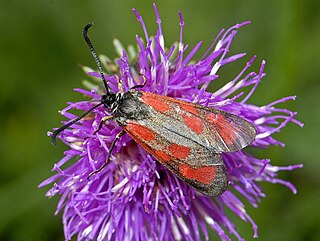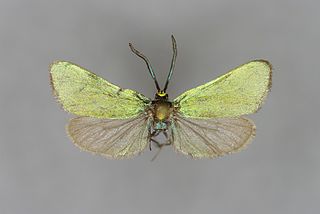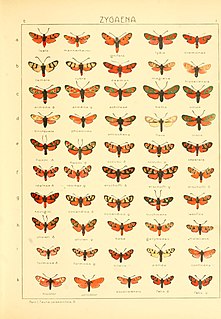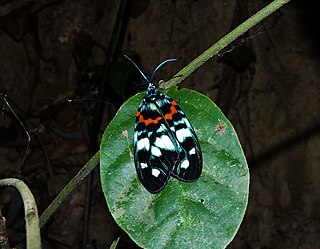
The Zygaenidae moths are a family of Lepidoptera. The majority of zygaenids are tropical, but they are nevertheless quite well represented in temperate regions. Some of the 1000 or so species are commonly known as burnet or forester moths, often qualified by the number of spots, although other families also have 'foresters'. They are also sometimes called smoky moths.

The Zygaeninae are a subfamily of the Zygaenidae family of moths. These are day-flying moths. Species of the genus Zygaena are native to the West Palearctic, while the genus Reissita is found on the Arabian Peninsula. They are able to biosynthesise hydrogen cyanide, and their bright patterns are warning colours to potential predators.

Zygaena is a genus of moths in the family Zygaenidae. These brightly coloured, day-flying moths are native to the West Palearctic.

Zygaena loti, the slender Scotch burnet, is a moth of the family Zygaenidae. It is a diurnal moth characterized by a black body, light colored legs, and red spots on its wings. The caterpillars are a yellow-green color and usually molt out of dormancy in late February to early March. The larvae feed on plants from the family Fabaceae until they enter their pupal stage and mature into adults in May to early June. For mating, Zygaenidae exhibit a dual-partner finding strategy, where females use pheromones while assuming a calling position, and males exhibit a patrolling behavior where they utilize both vision and the olfactory receptors in their antennae to locate a potential mate.

Jordanita chloros is a moth of the family Zygaenidae.

Jordanita tenuicornis is a moth of the family Zygaenidae.

Neurosymploca? oligocenica is an extinct species of moth in the family Zygaenidae, and possibly in the modern genus Neurosymploca. The species is known from Early Oligocene, Rupelian stage, lake deposits near the commune of Céreste in the Alpes-de-Haute-Provence, France.

Zygaena orana is a species of moth in the family Zygaenidae. It is found on Sardinia and in North Africa, including Morocco, Algeria and Tunisia.

Zygaena sogdiana is a species of moth in the Zygaenidae family. It is found in Central Asia.

Zygaena kavrigini is a species of moth in the Zygaenidae family. It is found in Central Asia. Seitz states Z. kavrigini Gr.-Grsh. has the abdomen mostly entirely red, inclusive of base; from Kuchara. The larva feeds on Alhagi canescens

Zygaena rosinae is a species of moth in the Zygaenidae family. It is found in Armenia. Z. rosinae Korb (7f), from Armenia, resembles scovitzii but the palpi and nearly the whole abdomen, especially in the female are bright red.

Zygaena olivieri is a species of moth in the Zygaenidae family. It is found in Syria, Armenia and Georgia. Seitz describes it -In olivieri Boisd. (7h) not only the collar and 2—8 abdominal segments are red but also the patagia, the red spots of the forewing being very large; from Syria and Armenia.In subspecies Z. o. laetifica Herrich-Schäffer, 1846 the pairs of spots on forewing are separate. — In Z. o. ganimedes Freyer, [1851] from Amasia, the penultimate pair of spots and the apical patch are rather broadly connected and the red markings of the forewing have a white edge of about 1 mm width.

Zygaena cuvieri is a species of moth in the Zygaenidae family found from Armenia and Syria to Central Asia. In Seitz it is described as follows: "This large fine Burnet has rosy-red wings, the forewing being divided into 3 areas by two black-grey bands; a broad collar and a rosy abdominal belt. Inhabits Anterior Asia, from Syria through Mesopotamia to Turkestan."

Zygaena manlia is a species of moth in the Zygaenidae family. It is found in Armenia, Turkey and Iran.In Seitz it is described as - "Similar to Zygaena cuvieri and with an equally broad rosy red collar and abdominal belt, but the blackish bands separating the red areas of the forewing are much broader, the distal area being represented by an irregular half-divided patch. North Persia"

Zygaena haberhaueri is a species of moth in the Zygaenidae family. It is found in Armenia and Georgia In Seitz it is described With red collar, but without red belt. On forewing obliquely from costa to anal angle an evenly wide greyish black band separating a triangular marginal patch from the red area of the wing, this area moreover being costally incised at the basal third or divided by a slight band. In Armenia, apparently in localities where for a long while past no collections have been made.

Zygaena cacuminum is a species of moth in the Zygaenidae family. It is found in Iran.In Seitz it is described This species reminds one in pattern of the carniolica-group, the 6. spot of the forewing being parallel to the distal margin. But the colour of all the spots of the forewing as well as of the hindwing is a dull purple, as it hardly occurs again in the whole genus. From Iran.

Zygaena lydia is a species of moth in the Zygaenidae family. It is found in Kurdistan and Kherson Oblast.

Zygaena separata is a species of moth in the Zygaenidae family. It is found in Southern Fergana ( Uzbekistan). Zygaena separata was described as ab. separata Stgr. of fraxini. It differs in that the distal spots are narrowly but distinctly separated from one another.

Neurosymploca is a genus of moths belonging to the family Zygaenidae.

Erasmia pulchella is a species of moth in the burnet moth family Zygaenidae and in the subfamily Chalcosiinae. It was described by Frederick William Hope in 1840. It is found throughout Southeast Asia, with its range stretching from northern India, Myanmar, Laos, Thailand, Vietnam, China, Taiwan, and Japan. It is the type species of the genus Erasmia.
















